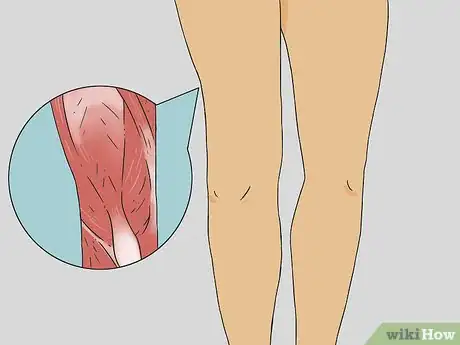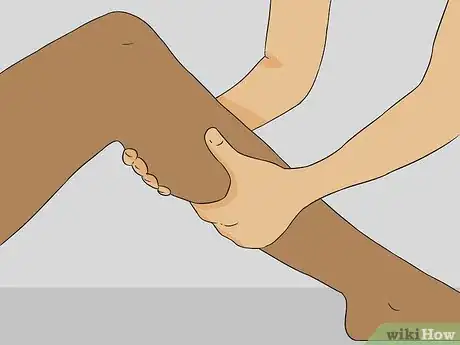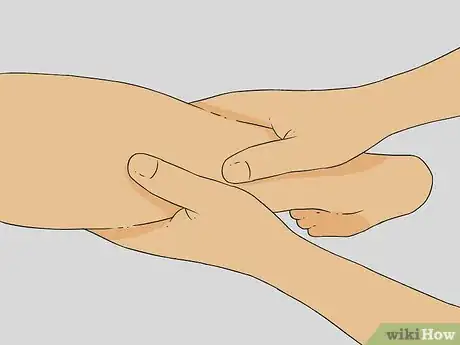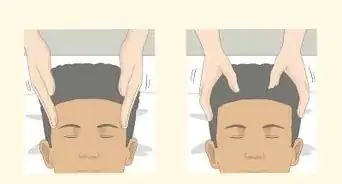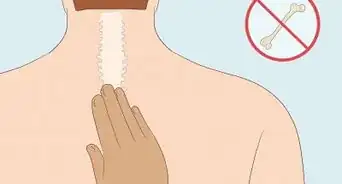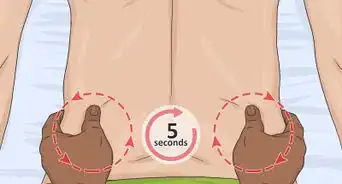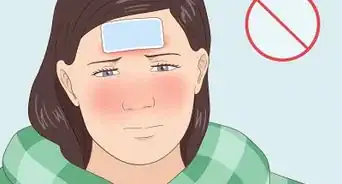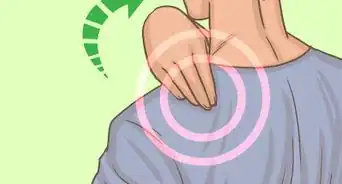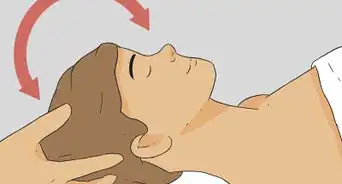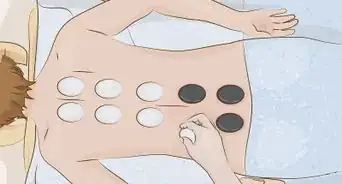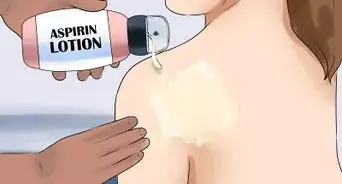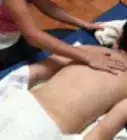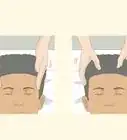This article was co-authored by Marty Morales. Marty Morales is a Professional Massage Therapist and the Founder and Owner of the Morales Method, a manual therapy and body conditioning business based in the San Francisco Bay Area and in Los Angeles, California. Marty has over 16 years of massage therapist experience and over 13 years of experience educating others on the best practices for massage therapy. Marty has over 10,000 hours of private practice logged and is a Certified Advanced Rolfer and Rolf Movement Practitioner, CMT. He has an MBA in Finance from Loyola Marymount University, Los Angeles.
There are 7 references cited in this article, which can be found at the bottom of the page.
This article has been viewed 218,864 times.
Giving someone a leg massage can be a way to help relieve leg pain caused by things like overexertion. Help the person find a comfortable position and then work your way from the feet upward. If leg pain is persistent, it may be caused by an underlying health condition. If someone's leg pain does not pass on its own, they should see a doctor.
Steps
Establishing the Basics
-
1Learn about basic anatomy. It's helpful to know some anatomy before you give a massage. Thigh muscles are in 4 basic groups which run from the hips down to the knee, in the front, sides, and backs of the legs. Knowing where the bones are located should also be helpful because the tissues that connect muscle to bone are important to massage.
- The connective tissues around the joints, like the hips, the knees, the ankles and the feet, can be pulled, kneaded, or compressed.
- The hamstrings and calves in the back of the leg are notoriously tight and people who run often have issues related to the outer thigh area, the TFL, or the IT band.
-
2Figure out how to apply pressure. Start the massage with gentle techniques and use lighter pressure near bones and sensitive areas. As circulation increases, so can the intensity of the massage. Move your fingers and hands quickly and lightly or slowly and firmly, but not quickly and firmly.[1]
- The body parts you use to perform a massage affect the pressure. The elbows generally provide the strongest pressure. The palms and fingers will generally apply less pressure.[2]
- Deeper tissue massage can include pressing down with the heel of the hand, the thumb, one hand on top of the other hand, the knuckles, a fist, or the forearm.
- Types of massage include gliding, kneading, compression, friction, percussion, vibration, jostling and range of motion movements.[3]
Advertisement -
3Choose your oils (optional). If you want, it's okay to use oil for a leg massage. This can make it easier to run your hands and fingers over someone's legs and oils can also provide a soothing effect. For leg massages, go for oils like olive oil, avocado oil, or almond oil. You can also use essential oils, or oils that are infused with scents such as lavender, eucalyptus, and tea tree, for a pleasantly aromatic experience.[4]
- Make sure the person you're massaging does not have an existing allergy to the oil you use.
- To warm up the oil in advance, put the bottle in some warm water.[5]
-
4Find a comfortable position. To start, help the person you're massaging find a comfortable position. For leg massages, it's usually easy to lie down somewhere like a bed. The person can have their legs stretched forward. If you're only massaging one leg, you may want to have the person lie on their side with the leg you're massaging extending upward. You can also have the person lie with their legs stretched out and elevated slightly. A pillow can be used to elevate the person's legs.[6]
-
5Communicate with the person. Ask the person if there's a particular area where they want extra pressure or attention. For example, if someone's thighs are bothering them, they may want you to focus on massaging their thighs. You may want to linger on certain areas and give them more attention.
- Keep communication open throughout the massage and ask the person how they're feeling so you can adjust your technique if necessary.[7]
Massaging Both Legs
-
1Start at the foot. Starting at the foot and stroking upward helps promote blood circulation, which can help ease pain and tension in the legs. Sandwich the person's foot between your palms. Then, put some oil into your palm and rub the foot firmly for a few minutes. When you're done rubbing the foot between your hands, give the foot a few gentle strokes moving from the toes to ankles.[8]
-
2Use long, gentle strokes along the outside of the thighs and calves. Move upward from the foot towards the thighs and calves. For these areas, use a loose fist to make long, gentle strokes. Move from the foot upward when you make your strokes. This pushes blood towards the heart, increasing blood circulation.[9]
-
3Massage the calves. Shift your focus to the lower half of the leg. Slide your hands up over the shin area from the ankle to just below the knee. Then move your hands behind the leg to the calf area and slide all the way back down to the ankle. After doing this a few times, work your way up and down the lower leg by using your thumbs to knead and scoop the sides of the leg.[10]
-
4Finish by massaging the thighs. Work your way up the thigh area. Make scooping passes with your hands on the outside and inside of the leg to stimulate the different muscles in the upper leg. Apply some pressure as you use your palm to press near the center of the upper thigh and gluteal areas.[11]
Taking Safety Precautions
-
1Be very gentle with swollen legs. If legs are swollen due to medical reasons, be very gentle. Make sure to check with the person to make sure they're comfortable. Use the lightest pressure possible when massaging swollen legs.[12]
-
2Avoid massaging the inner thighs on a pregnant woman. If you're massaging a pregnant woman's legs, stay away from massaging the inner thighs. Blood clots are more common in this area during pregnancy and massaging the area can dislodge clots. This can be a very serious, even fatal, problem.[13]
-
3See a doctor for chronic leg pain. Leg pain can indicate health problems such as a leg injury or chronic conditions like arthritis.[14] While massages can temporarily relieve, frequent leg pain should be evaluated by a medical professional.
Expert Q&A
-
QuestionHow much pressure do you use in a massage?
 Marty MoralesMarty Morales is a Professional Massage Therapist and the Founder and Owner of the Morales Method, a manual therapy and body conditioning business based in the San Francisco Bay Area and in Los Angeles, California. Marty has over 16 years of massage therapist experience and over 13 years of experience educating others on the best practices for massage therapy. Marty has over 10,000 hours of private practice logged and is a Certified Advanced Rolfer and Rolf Movement Practitioner, CMT. He has an MBA in Finance from Loyola Marymount University, Los Angeles.
Marty MoralesMarty Morales is a Professional Massage Therapist and the Founder and Owner of the Morales Method, a manual therapy and body conditioning business based in the San Francisco Bay Area and in Los Angeles, California. Marty has over 16 years of massage therapist experience and over 13 years of experience educating others on the best practices for massage therapy. Marty has over 10,000 hours of private practice logged and is a Certified Advanced Rolfer and Rolf Movement Practitioner, CMT. He has an MBA in Finance from Loyola Marymount University, Los Angeles.
Professional Massage Therapist It depends on the person you're massaging. You don't need to apply much pressure to give a good massage. Talk to the person you're massaging to find out what's comfortable to them.
It depends on the person you're massaging. You don't need to apply much pressure to give a good massage. Talk to the person you're massaging to find out what's comfortable to them. -
QuestionHow do you warm up oil?
 Marty MoralesMarty Morales is a Professional Massage Therapist and the Founder and Owner of the Morales Method, a manual therapy and body conditioning business based in the San Francisco Bay Area and in Los Angeles, California. Marty has over 16 years of massage therapist experience and over 13 years of experience educating others on the best practices for massage therapy. Marty has over 10,000 hours of private practice logged and is a Certified Advanced Rolfer and Rolf Movement Practitioner, CMT. He has an MBA in Finance from Loyola Marymount University, Los Angeles.
Marty MoralesMarty Morales is a Professional Massage Therapist and the Founder and Owner of the Morales Method, a manual therapy and body conditioning business based in the San Francisco Bay Area and in Los Angeles, California. Marty has over 16 years of massage therapist experience and over 13 years of experience educating others on the best practices for massage therapy. Marty has over 10,000 hours of private practice logged and is a Certified Advanced Rolfer and Rolf Movement Practitioner, CMT. He has an MBA in Finance from Loyola Marymount University, Los Angeles.
Professional Massage Therapist Place the bottle of oil into warm water and wait for it to warm up. Keep the oil in the water until you're ready to do the massage.
Place the bottle of oil into warm water and wait for it to warm up. Keep the oil in the water until you're ready to do the massage. -
QuestionIs it possible to massage a leg after tendon surgery?
 Community AnswerI wouldn’t recommend it, especially if you’ve gotten stitches in that area. If you do massage after surgery and the stitches become undone, contact your doctor immediately.
Community AnswerI wouldn’t recommend it, especially if you’ve gotten stitches in that area. If you do massage after surgery and the stitches become undone, contact your doctor immediately.
References
- ↑ http://www.alive.com/health/massage-to-aid-circulation/
- ↑ http://www.yogawiz.com/massage-therapy/leg-massage-techniques.html
- ↑ http://www.massageschoolnotes.com/massage-theory/
- ↑ http://www.yogawiz.com/massage-therapy/leg-massage-techniques.html
- ↑ Marty Morales. Certified Massage Therapist. Expert Interview. 20 December 2019.
- ↑ https://www.babble.com/pregnancy/pregnancy-massage-couples-guide/
- ↑ Marty Morales. Certified Massage Therapist. Expert Interview. 20 December 2019.
- ↑ http://www.alive.com/health/massage-to-aid-circulation/
- ↑ https://www.babble.com/pregnancy/pregnancy-massage-couples-guide/
- ↑ https://www.youtube.com/watch?v=XsJEQTFTKfY
- ↑ http://www.dailymotion.com/video/x1wsa9j
- ↑ http://www.alive.com/health/massage-to-aid-circulation/
- ↑ https://www.babble.com/pregnancy/pregnancy-massage-couples-guide/
- ↑ http://www.yogawiz.com/massage-therapy/leg-massage-techniques.html
- ↑ Marty Morales. Certified Massage Therapist. Expert Interview. 20 December 2019.
About This Article
If you want to give someone a leg massage, start at the foot and stroke upwards to promote blood circulation and ease pain or tension in their legs. As you move up to their calves and thighs, use a loose fist to make long, gentle strokes. Slide your hands up over their shin, just below the knee, then move your hands behind their leg and slide back down to their ankle. For the best results, use your thumbs to knead and scoop the sides of the leg as you massage. After doing this a few times, massage their thighs on the outside and inside of their leg. Make sure to apply some pressure as you press your palm near the center of the upper thigh and gluteal areas. For more tips from our Fitness co-author, like how to use oils during a leg massage, scroll down!
